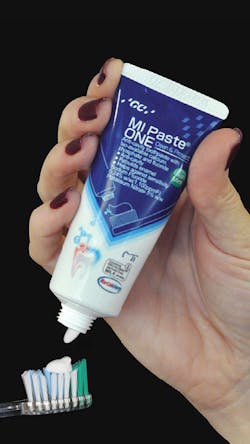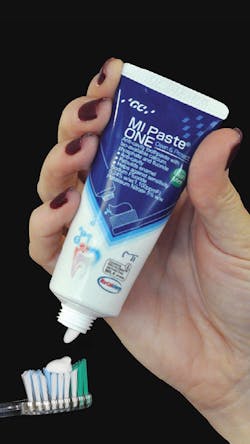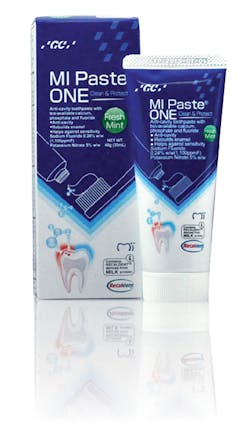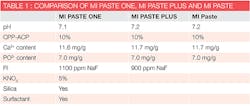Caries management: Simplify product selection to improve compliance and outcome
By Pamela Maragliano-Muniz, BSDH, DMD
As dental professionals, we evaluate our patients on a routine basis and continually provide strategies to prevent dental caries. These strategies include caries risk assessment1 and individualized risk management recommendations. There is an abundance of products on the market and it can be challenging for dental professionals to hone their recommendations. In general, caries management programs receive criticism for being time consuming and complicated for private practices. It is essential to streamline and simplify2 caries management for the private practice it can be practiced routinely and indefinitely. The purpose of this article is to discuss simple strategies to get the maximum impact of caries management within the private practice.
Getting Started
Before implementing a caries management program, it is vital for the dental or dental hygiene practice to plan and organize as a team. A few items for consideration include:
- Understanding the caries process. It is essential to become educated in the caries process so that risk assessment and risk management can be tailored for each individual practice.
- Caries risk assessment. Which team member will provide risk assessment? How will risk be assessed; will a questionnaire be used or will caries risk be assessed using another method?
- Caries risk management. Who will make risk management recommendations? How will this information be conveyed, verbally or via handouts?
- Product recommendations. It is important to decide which products will be recommended for patients in each risk category, including toothbrushes, interdental cleaning strategies and topical pastes.
- Documentation. Documenting caries risk assessment, caries risk category assignment, risk management recommendations and patient’s acceptance of your recommendations is essential. Custom documentation templates within the electronic health record are particularly useful to calibrate different members of the dental team.
The Caries Process
Historically, dental caries was thought to be the result of the interaction of a susceptible tooth, fermentable carbohydrates and time.3 Later research uncovered that the progression of dental caries is multifactorial4 is significantly more complex5. Dental caries is the result of an oral environment that is conducive to the progressive demineralization of the hard structures in the oral cavity. This net loss of tooth mineral is due, in part, to the proliferation of cariogenic bacteria that thrive in a low-pH (acidic) environment.6
Risk management can be particularly challenging; there are numerous products available to dental professionals and selecting products for the private practice can be confusing. If multiple products are dispensed in the private practice, patient education is critical. Products can be used improperly, which can lead to reduced efficacy of products and a challenge for patient compliance.
The Role of the Dental Hygienist
Dental hygienists play a significant role in the implementation of a caries management program in clinical practice. Caries risk assessment and risk management is ideally carried out during a dental hygiene appointment as dental hygienists treat patients on regular intervals and have the unique opportunity to monitor patients’ progress. Assessments may include the use of questionnaires, documentation templates, online resources or bacterial and/or pH testing.
Dental hygienists also routinely provide recommendations to promote health during recare or maintenance appointments. Dental hygienists can inform patients of their individual risk classifications and provide risk management recommendations. These recommendations include individualized oral hygiene instructions, diet or behavior modification and product recommendations.
Documentation—A successful caries management program includes documentation that includes identification of risk factors, caries risk category classification, risk management recommendations and patient acceptance. Standardized documentation will enable clinicians improved communication and a complete record of the dental hygiene appointment.
A Single Ingredient with Maximum Impact
Many dental professionals struggle with caries management programs because it may not only be confusing to select products, but also to encourage patient compliance. In addition, once products are selected, many struggle with the perceived pressure to “sell things” to patients. Dispensing products that serve multiple functions may mitigate these concerns.
When selecting products, understanding the mechanism of action will help hone the decision making process for the practice. Moreover, understanding the impact of risk factors on the oral environment will enable the clinician to make product recommendations. For instance, RECALDENTTM (CPP-ACP or casein phosphopeptide-amorphous calcium phosphate) acts as a salivary biomimetic that encourages stabilized calcium and phosphate ions7 to facilitate a variety of positive effects on the oral cavity.
Products that contain CPP-ACP have features that impact the oral environment in multiple ways:
Buffers plaque acids—In a recent study8, it was found that the lowest pH drop, the fastest pH recovery and the least pH changes were found in children when teeth were treated with CPP-ACP after a topical fluoride treatment, when compared to rinsing with water after a topical fluoride treatment or being treated by fluoride alone. It is accepted that CPP-ACP, when incorporated into dental plaque, will counteract the pH drop that is caused by acidogenic bacteria9.
Synergy with fluoride for enhanced inhibition of demineralization and promotion of subsurface enamel remineralization—CPP-ACP has proven to promote sub-surface enamel remineralization. This is particularly useful for reversing white spot lesions10 and aiding in the stabilization or repair of early caries lesions. This occurs due to the stabilized calcium that is supplied by CPP-ACP is incorporated into the pellicle and the tooth’s surface. CPP-ACP additionally encourages the incorporation of fluoride into dental plaque and sub-surface enamel.11 Fluoride enhances remineralization by the formation of fluorapatite on the surface of the tooth. Remineralization occurs due to an interaction of calcium ions and fluorapatite; they have an additive effect in the remineralization of early carious lesions. This effect is greater when fluoride and CPP-ACP work synergistically when compared to working individually.12
Improved Plaque Ecosystem—CPP-ACP has antimicrobial properties; CPP-ACP suppresses the adherence of streptococcus mutans13 and encourages the proliferation of commensal bacteria, resulting in non-cariogenic plaque.14, 15
Delivery Systems
Historically, products containing CPP-ACP were limited to chewing gums16 (in limited doses) and topical pastes17 that would be applied to clean teeth. Topical pastes containing CPP-ACP are available in two forms: with fluoride (900ppm and now 100ppm) and without fluoride. Although these pastes have been proven effective and offer many features, it was not intended for use as a dentifrice. Recently, a dentifrice containing Recaldent has become available.
MI Paste ONE (GC America Inc.) is the only dentifrice available that contains Recaldent. It offers a two-in-one application system; the “extra step” of applying MI Paste Plus is eliminated and MI Paste ONE essentially combines toothpaste + MI Paste Plus.
MI Paste ONE is a low-abrasive (RDA= 64) paste that additionally contains 5% potassium nitrate for improved antihypersensitivity properties. For a comparison of MI Paste ONE with its predecessors, see table 1. MI Paste ONE is sodium lauryl sulfate (SLS) free. It can be used to replace one’s existing toothpaste and the recommendations include brushing teeth with this product for two minutes, expectorate, and do not eat, drink or rinse for 30 minutes after use.
Benefits of MI Paste ONE include anti-caries, anti-sensitivity, rebuilds enamel via supplying bioavailable CPP-ACP and fluoride, anti-erosion, white spot prevention, pH buffering/neutralize acids and whitening (via stain prevention and removal).18
MI Paste ONE is available in a mild, refreshing mint flavor and is currently available to be incorporated into risk management recommendations.
Caries management can be successfully implemented into clinical practice when risk assessment, risk management and documentation are tailored for efficiency. Simplifying product recommendations by suggesting products that have multiple preventive properties may help practitioners minimize the number of recommended products and ultimately improve patient compliance and clinical outcomes.
Editor’s note: This article’s preparation was supported by GC America.
Pamela Maragliano-Muniz, BSDH, DMD, was a dental hygienist before earning her DMD from Tufts University School of Dental Medicine and her certificate in advanced prosthodontics from UCLA School of Dentistry. She is on faculty at Tufts University School of Dental Medicine, and maintains a private practice in Salem, Mass. She is the editorial director for DentistryIQ.com’s Pearls for Your Practice. In 2010, Dr. Maragliano-Muniz was awarded the Adult Preventive Care Practice of the Year by the American Dental Association.
References
1. Fontana M, Zero D. Assessing Patients’ Caries Risk. JADA. Sept 2006; 137(9); 1231-9.
2. Young DA, Featherstone J., Caries management by risk assessment. Community Dent and Oral Epidemio. Feb 2013; 41(1): e53-63.
3. Fitzgerald RJ, Keyes PH. Ecologic Factors in Dental Caries. Am J Pathol. 1963 Jun; 42(6): 759-72.
4. Ritter AV, Eidson RS, Donovan TE. “Dental caries: Etiology, clinical characteristics, risk assessment, and management.” Sturdevant’s Art & Science of Operative Dentistry-E-Book (2014): 41.
5. Simón-Soro A, Mira A. “Solving the etiology of dental caries.” Trends in microbiology 23.2 (2015): 76-82.
6. Kutsch, VK, Dental caries: An updated medical model of risk assessment. J Prosthet Dent. 2014, Apr: 111(4);280-5.
7. Cochrane NJ, Saranathan S, Cai F, Cross KJ, Reynolds EC. Enamel subsurface lesion remineralisation with casein phosphopeptide stabilised solutions of calcium, phosphate and fluoride. Caries Res. 2008; 42(2):88-97.
8. Fatemeh M, Marjan S, Homa N, Mahsa S. CPP-ACP: Effect on Dental Plaque Acidity after Water Rinsing Following Topical Fluoride. J Clin Pediatr Dent. 2014;41(1): 22-6.
9. Nongonierma AB, Fitzgerald RJ. Biofunctional properties of caseinophosphopeptides in the oral cavity. Caries Res. 2012; 46(3): 234-67.
10. Guclu ZA, Alacam A, Coleman NJ. A 12-week Assessment of the Treatment of White Spot Lesions with CPP-ACP Paste and/or Fluoride Varnish. Biomed Res Int. 2016;2016:8357621. (online publication).
11. Reynolds EC, Cai F, Shen P, Walker GG. Retention in plaque and remineralization of enamel lesions by various forms of calcium in a mouthrinse or sugar-free chewing gum. J Dent Res. 2003 Mar; 82(3): 206-11.
12. Huq NL, et al. “The Interactions of CPP–ACP with Saliva.” Ed. Eva Freisinger. International Journal of Molecular Sciences 17.6 (2016): 915. PMC. Web. 17 Sept. 2017.
13. Grychtol S, Basche S, Hannig M, Hannig C. Effect of CPP/ACP on initial bioadhesion to enamel and dentin in situ. Scientific World J. 2014;2014:52682. Doi: 10.1155/2014/512682. Epub 2014 Oct 21.
14. Schupbach P, Neeser JR, Golliard M, Rouvet M, Guggenheim, B. Incorporation of caseinophosphopeptide into the salivary pellicle inhibits adherence of mutans streptococci. J Dent Res. 1996 Oct; 75(10); 1779-88.
15. Chandak S, Bhondey A, Bhardwaj A, Pimpale J, Chandwani M. Comparative evaluation of the efficacy of fluoride varnish and casein phosphopeptide- Amorphous calcium phosphate in reducing Streptococcus mutans counts in dental plaque of children: An in-vivo study. J Int Soc Prev Community dent. 2016 Sep-Oct; 6(5): 423-9.
16. de Oliveira AF, de Oliveira Diniz LV, Forte FD, Sampaio FC, Ccahuana-Vasquez RA, Tochukwu Amaechi B. In situ effect of a CPP-ACP chewing gum on enamel erosion associated or not with abrasion. Clin Oral Investig. 2017 Jan; 21(1): 339-46.
17. Reema SD, Lahiri PK, Roy, SS. Review of casein phosphopeptides-amorphous calcium phosphate. Chin J Dent Res. 2014; 17(1): 7-14. Review.
18. Product details supplied by manufacturer



